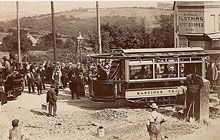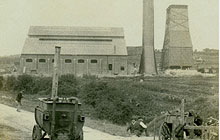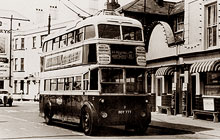Trams & Trolleybuses
Hastings Tramways
The Hastings Tramways Company was founded in early 1904, and construction of the Hastings tramways soon began, included the building of the main Silverhill depot. The first tramcars arrived in July 1905 and the Official Tram Trial Trip ran on 15th July from Silverhill to the Memorial in the town centre. Public service then began, running the original circular route.
A further line from Ore to the Market Ccross in the Old town was opened in August of the same year. The extension from Silverhill to the Seafront via London Road was opened in July 1906.
A second tram depot was built at Bulverhythe and services started between St Leonards and Bexhill in April 1906. This line finally reached the isolated outpost of Cooden (then called Kewhurst) in July 1906. The Bexhill section included a length of private tramroad accross Pebsham Marsh from Egerton Park to Cooden Beach.
January 1907 saw the two systems joined, connecting along the seafront. It was a double track opearated using the Dolter stud contact system which was known to sometimes electrocute horses.
By 1913 the Dolter system was considered dangerous and all seafront-running cars were fitted with a petrol engine attached to a dynamo which fed the existing controllers with electric. The first petrol car ran in 1914 but the petrol experiment didn't last long and the council allowed over-head wires along the seafront in 1921.
The total length of the Hastings Tramway system reached just short of 20 miles and by September 1926 service numbers were introduced for the following routes:
- Silverhill - St Leonards - Ore
- Ore - High Street (Market Cross)
- Bexhill - Ore
- Hollington - Bohemia Road - Memorial
- Ore - Bexhill
- Cooden - St Helens (Cemetery)
- St Helens - Cooden
- Circular via Bohemia Road
- Circular via St Helens
Services 3, 5, 6 and 7 were run in both directions.
1927 saw the replacement of the trams with trolleybuses. Many of the old tram lines were used to strengthen the concrete blocks used in the sea defences when the parade extension was built by Sidney Little in the 1930’s.
Tramway Power Station
Power for the Hastings trams was generated by six engines totalling 3150hp. These were housed in the main power station which was built on a dirt track in Ore Valley, now named Parker Road. The power station had a distinctive 175ft steel plate chimney and was serviced by a railway siding from SECR. Substations were situated at both Bulverhythe and Silverhill.
Hastings Trolleybuses
In the mid-1920's Hastings council began to think of other options instead of the trams and finally the conversion from trams to trolleybuses was completed in April 1928 with the last tram running in March of that year.
Hundreds of cast iron poles needed to be erected to support the overhead wires used for power. In some of the more narrow streets the wires were attached to the buildings with large cast iron blocks.
The original trolleybuses were built by Guy Motors with electrical equipment supplied by the British Thomson-Houston Company. Each bus had two 40hp self-ventilated interpole traction motors, consuming 500 volts at 70 amps.
They were taken over by the Maidstone & District Company in 1957 and finally withdrawn in May 1959, being replaced by Leyland single and double decker buses.
Happy Harold was restored in 1953 and took part in the Coronation celebrations.



